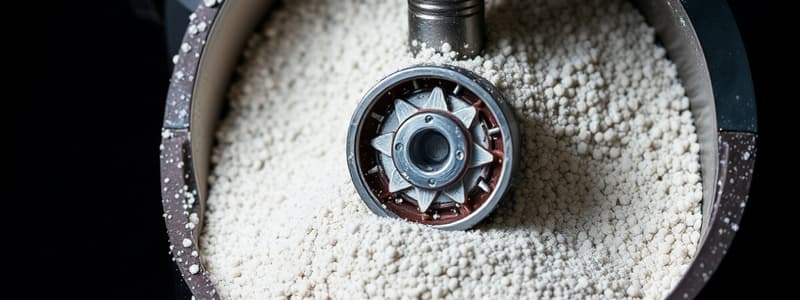Podcast
Questions and Answers
How does adjusting the frequency and amplitude in a vibratory mill influence the grinding process?
How does adjusting the frequency and amplitude in a vibratory mill influence the grinding process?
Adjusting the frequency and amplitude affects the mechanical impact and the degree of pulverization, with frequency being the main parameter for controlling particle size.
What role does impact force play in an impact mill, and how can it be manipulated?
What role does impact force play in an impact mill, and how can it be manipulated?
The particle size in an impact mill is directly related to the impact force, which can be manipulated by adjusting the velocity and impact energy.
Explain the importance of real-time monitoring in the grinding process.
Explain the importance of real-time monitoring in the grinding process.
Real-time monitoring is crucial as it provides data on particle size, temperature, and energy consumption, allowing for immediate adjustments to maintain desired outcomes.
What is the purpose of implementing feedback systems in the grinding process?
What is the purpose of implementing feedback systems in the grinding process?
How can experimental design contribute to the optimization of particle size in grinding processes?
How can experimental design contribute to the optimization of particle size in grinding processes?
How do the properties of feed material affect the final particle size during grinding?
How do the properties of feed material affect the final particle size during grinding?
What role does the grinding media play in determining particle size?
What role does the grinding media play in determining particle size?
Explain how grinding time influences particle size.
Explain how grinding time influences particle size.
Discuss the relationship between energy input and particle size in the grinding process.
Discuss the relationship between energy input and particle size in the grinding process.
How does fluid velocity affect particle size in wet grinding processes?
How does fluid velocity affect particle size in wet grinding processes?
What impact does temperature have on the grinding process and particle size?
What impact does temperature have on the grinding process and particle size?
How does the configuration of grinding equipment affect the outcome of particle size distribution?
How does the configuration of grinding equipment affect the outcome of particle size distribution?
Identify the significance of ball mill parameters in determining particle size distribution.
Identify the significance of ball mill parameters in determining particle size distribution.
Flashcards
Vibratory Mill
Vibratory Mill
A machine that uses vibration to break materials by adjusting frequency and amplitude.
Impact Mill
Impact Mill
A mill where particle size is controlled by the force of impact and velocity.
Process Monitoring
Process Monitoring
Real-time tracking of parameters during grinding to adjust for desired particle size.
Feedback Systems
Feedback Systems
Signup and view all the flashcards
Quality Control
Quality Control
Signup and view all the flashcards
Feed Material Properties
Feed Material Properties
Signup and view all the flashcards
Grinding Media
Grinding Media
Signup and view all the flashcards
Grinding Time
Grinding Time
Signup and view all the flashcards
Grinding Energy
Grinding Energy
Signup and view all the flashcards
Fluid Velocity
Fluid Velocity
Signup and view all the flashcards
Temperature in Grinding
Temperature in Grinding
Signup and view all the flashcards
Grinding Equipment Configuration
Grinding Equipment Configuration
Signup and view all the flashcards
Ball Mill Parameters
Ball Mill Parameters
Signup and view all the flashcards
Study Notes
Process Parameters Affecting Particle Size
- Feed material properties directly affect particle size; these include hardness, cohesiveness, moisture content, and initial particle size distribution. Changes in any of these significantly alter the final product. Harder materials need more energy for reduction.
- Grinding media type, size, and shape influence achievable particle sizes. Harder, more durable media are better for tougher materials. The media-to-material ratio impacts results; higher ratios may yield larger particle sizes.
- Increased grinding time generally leads to finer particle size, but prolonged grinding can cause excessive energy consumption or product degradation. Optimizing time is key for efficiency and product quality.
- Grinding energy significantly affects particle size. More energy usually results in finer particles, but excessive energy can cause equipment wear. Careful monitoring and control are necessary.
- In wet grinding, fluid velocity directly influences particle size. Higher velocities increase attrition and collision rates, leading to finer particles.
- Temperature impacts particle size in some grinding processes. Higher temperatures can change material properties, affecting hardness or susceptibility to breakage.
- Grinding equipment configuration—design, like ball mill, vibratory mill, or impact mill—affects force and contact mechanisms during grinding. This impacts particle size distribution and uniformity. Design parameters, such as mill diameter, rotation speed, and filling level, are crucial.
Equipment Specific Parameters
- Ball mill design, fill level, rotation speed, and grinding media size directly influence particle size distribution. Different ball sizes and combinations alter impact and attrition on feed material. Speed affects the kinetic energy for grinding.
- Vibratory mills use varying frequencies and amplitudes of vibration to break material. Adjusting these affects mechanical impact and pulverization. Frequency is often the primary parameter for particle size control.
- In impact mills, particle size is directly related to impact force. Adjusting velocity and impact energy affects breakage. Material properties and the distance between impact components influence achievable size.
Process Control
- Real-time process monitoring provides data for immediate adjustments to maintain desired particle size. Sensor data on particle size, temperature, and energy consumption is essential.
- Feedback systems automatically respond to deviations from target particle size specifications, automating parameter adjustments for process stability.
- Frequent quality checks of particle size distribution identify patterns and optimize consistent outcomes. Methods might include sieving or image analysis.
- Experimental design, using controlled environments and varying parameter levels, improves prediction and control of final particle size. Statistical methods and process modeling increase optimization efficiency.
Studying That Suits You
Use AI to generate personalized quizzes and flashcards to suit your learning preferences.




